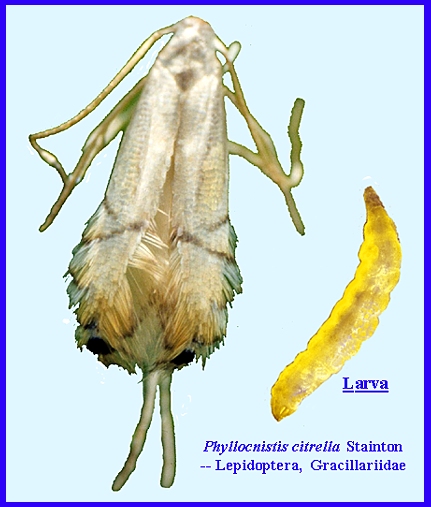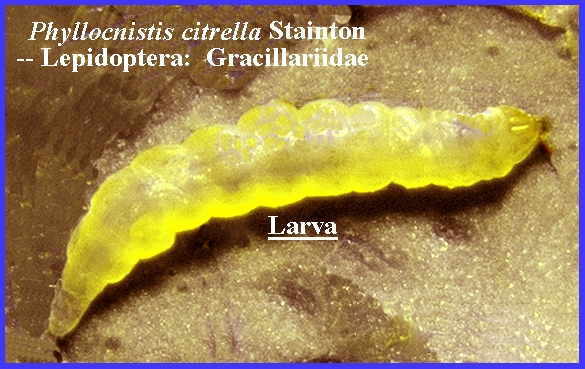File: <citrusleafminer > Pooled References GENERAL
INDEX [Navigate to MAIN MENU ]
|
Citrus Leafminer Phyllocnistis citrella Stainton --
Lepidoptera: Gracillariidae |
------ CLICK on photo to enlarge. Link
to further detail = Phyllocnlstis
----------------------------------------------------------------------------------------------------------------------------------
|
This
leafminer was first discovered in Florida in 1993 and subsequently spread to
Louisiana and Texas. It invaded
Australia, South Africa, parts of West and East Africa, the Mediterranean
area, Saudi Arabia to India, the Caribbean Islands, Central America, Mexico and South America. In 2000, it became established in southern
California, and has since spread northward into all major citrus growing
areas of the state. These small moths
can cause infestations of 90% in some areas.
Its arrival in southern California was believed to be from
Mexico. However, the native home of
the leafminer is unclear, although Southeast Asia is suspected. Adults
of the citrus leafminer are tiny moths (4 mm wingspread) with white and
silvery scales on the forewings, with several black and tan markings, plus a
black spot on each wingtip. The hind
wings and body are white, with long fringe scales extending from the hind
wing margins. The moth appears much
smaller when at rest (about 2mm). The
head is very smooth-scaled and white and the haustellum has no basal
scales. Citrus leafminer is most
easily detected by its meandering serpentine larval mine, usually on the
ventral side of the leaf. Larvae are minute (to 3 mm), translucent greenish
yellow, and located inside the leaf mine.
The pupa occurs is in a pupal cell at the leaf margin. Adults generally are too minute to be
easily noticed, and are active diurnally and evenings. The
larvae make serpentine mines in tender new leaves of all varieties of
citrus. The mining causes the new
flush to twist and curl and prevents it from expanding fully. Developmental time is about three weeks,
and as many as 7-8 generations occur in California. In Florida, where bacterial canker is present, leaf mining
activity creates opportunities for canker to enter, increasing the incidence
of this disease. In California, thus
far, the damage has been primarily to nursery trees and new plantings because
the larvae must have young citrus foliage to mine and feed on. The period of infestation of mature citrus
has been mainly in the fall months.
Mature citrus trees, except for coastal lemons, can tolerate heavy
fall flush damage with little impact to fruit production. Coastal lemons have continuous flushing of
leaves and produce multiple crops of fruit.
The continuous flushing allows prolonged infestations of the leafminer
that reduce tree vigor and fruit production. Control with insecticides is not
very effective and very destructive to balances of effective natural enemies
that were introduced earlier in citrus orchards for the control of other
pests. Local species of parasitoids
adapt quickly to the mines created by this insect. Thus, in time the infestations decline to noneconomic levels
unless disturbances such as insecticidal spraying occurs. Parasitoids reported for the citrus
leafminer include 39 species from Southeastern Asia, Japan, and Australia,
mostly Chalcidoidea (Heppner 1993; Kalshoven 1981; Lo and Chiu 1988). A pheromone to attract males of the
leafminer has been developed in Japan by Ando et al. (1985), called (7Z,
11Z)-7,11-hexadecadienal. Most work
has been done using chemical control, especially in India. Various spray
regimes, timing of growth flushes, and promotion of biological control are
recommended in Australia (Beattie 1989).
In Florida, chemical control recommendations are still being explored,
but biological control and semiochemical trapping may be the most likely
methods to help reduce populations of citrus leafminer in the long run. REFERENCES: FURTHER RELATED REFERENCES Ando, T., K. Y. Taguchi, M. Uchiyama, T. Ujiye & H. Kuroko. 1985. (7Z-11Z)-7,11-hexadecadienal:
sex attractant of the citrus leafminer moth, Phyllocnistis
citrella Stainton (Lepidoptera, Phyllocnistidae). Agric.Biol. Chem. Tokyo 49: 3633-3653. Badawy, A.
1967. The morphology and
biology of Phyllocnistis citrella
Strait, a citrus leaf-miner in the Sudan.
Bull. Soc. Ent. Egypte 51:95-103. Beattie, G.A.C. 1989.
Citrus Leaf miner. New South
Wales Agric. and Fisheries, Agfact, H2.AE
4: 1-4. Chiu, S. C.
1985. Biological control of
citrus pests in Taiwan. Taiwan Agric.
Res. Inst., Spec. Rep. 19: 1-8. Clausen, Curtis
P. 1927.
The citrus insects of Japan.
USDA, Washington, D.C. Tech. Bul. 15:
1-15. Clausen, Curtis
P. 1931.
Two citrus leaf miners of the Far East. USDA, Washington, D.C. Tech. Bull. 252: 1-13. Clausen, Curtis P. 1933. The citrus
insects of tropical Asia. USDA,
Washington, D.C. Cir. 266: 1-35. Commonwealth Agriculture Bureaux (CAB),
Commonwealth Institute of Entomology. 1970. Phyllocnistis
citrella Stnt. IN: Distribution maps of pests. Ser. A, Map No 274. The Eastern Press Ltd., London. Fletcher, T. B.
1920. Life histories of Indian
insects. Microlepidoptera. Mem. Dept.
Agric. India 6: 1-217,
68 pl. Heppner, J. B. 1993. Citrus Leafminer, Phyllocnistis citrella, in Florida
(Lepidoptera: Gracillariidae: Phyllocnistinae). Trop. Lepid. 4: 49-64. Hill, G. F.
1918. History of citrus canker
in the Northern Territory (with notes of its occurrence elsewhere). N. Terr. Austr. Bull.
18: 1-8. Ichtiar Baru
Margabandhu, V. 1933.
Insect pests of oranges in the northern Circars. Madras Agric. J. 21: 60-68. Lal, K.B. 1950.
Insect-pests of fruit trees grown in the plains. Agric. Anim. Husb. Uttar Pradesh 1: 30-45. Latif, A.
& C. M. Yunus. 1951.
Food plants of citrus leaf miner in Punjab. Bull. Ent. Res. 42:
311-316. Lo, K. C. & S.
C. Chiu. 1988. The illustrations of
citrus insect pests and their natural enemies in Taiwan. Taichung: Taiwan Agric. Res. Inst. 75 p. Pandey. N. D. & Y. D. Pandey. 1964.
Bionomics of Phyllocnistis citrella
Stt. (Lepidoptera: Gracillariidae). Indian J. Ent. 26:
417-423. Pruthi, H. S. & M. S. Mani. 1945.
Our knowledge of the insect and mine pests of the citrus in India and
their control. Imp. Council Agric.
Res. Sci. Monog. 16: 1-42. Reinking, O. A.,
& G. W. Groff. 1921.
The kao pan seedless Siamese pummelo and its culture. Philipp. J. Sci. 19: 389-437. Sasscer, E. R. 1915.
Important insect pests collected on imported nursery stock in
1914. J. Econ. Ent.
8: 268-270. Stainton, H. T.
1856. Descriptions of three
species of Indian Micro-Lepidoptera.
Trans. Ent. Soc. London (n.s.) 3:
301-304. Wilson, C. G.
1991. Notes on Phyllocnistis citrella Stainton
(Lepidoptera: Phyllocnistidae) attacking four citrus varieties in
Darwin. J. Austr. Ent. Soc. 30: 77-78. El-Heneidy, A. H. & Fawzia A. Hawwanein. 1986. Meteorus
gyrator Thunberg and M. rubens Nees. (Hymenoptera:
Braconidae), new recorded
parasitoids, on certain lepidopterous pests in Egypt. Zeitschrift angewandete
Entomologie (1986). Hawwanein,
Fawzia A. & A. H. El-Heneidy. 1988.
Comparative study of the parasitism by Microplitis rufiventris Kok. (Hymenoptera: Braconidae) and
Periboae orbate Wied. (Diptera:
Tachinidae) on main lepidopterous pests in vegetable crop fields in
Egypt. Bull. Soc. Ent. Egypte, Econ.
Ser. 17: 127 - 135. Hawwanein, Fawzia A., A. H. El-Heneidy; M. S. Abbas &
A. R. Hamed, A. R. 1985. Survey of the parasitoids of main
lepidopterous pests in vegetable crop fields in Egypt. Bull. Soc. Ent. Egypte, 65: 259 -265. Honda,
J. & S. V. Triapitzin. 1995a. A species
description and biological comparison between a new species of Telenomus
Haliday (Hymenoptera: Scelionidae) and Trichogramma
platneri Nagarkatti (Hymenoptera: Trichogrammatidae): two egg
parasitoids of Sabulodes aegrotata
(Guene=E9) (Lepidoptera: Geometridae).
Pan-Pacific Entomol. 71 (4): 227-236. Honda,
J. & S. V. Triapitzin. 1995b. A species
description and biological comparison between a new species of Telenomus
Haliday (Hymenoptera: Scelionidae) and Trichogramma
platneri Nagarkatti (Hymenoptera: Trichogrammatidae): two egg
parasitoids of Sabulodes aegrotata (Lepidoptera: Geometridae). Pan-Pacific Entomologist 72 (3): 168-170. Triapitzin, S. V. & T. M. Tretiakova. 1997.
Sexual behavior of Apanteles oenone
Nixon (Hymenoptera, Braconidae), an exotic parasitoid of the pink bollworm, Pectinophora gossypiella (Saunders) (Lepidoptera, Gelechiidae). Russian
Entomological Journal 6 (1-2): 71-72. |

